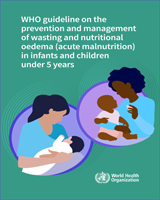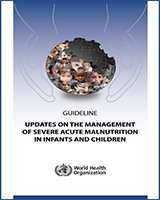Overview
This guideline provides global, evidence-informed recommendations on a number of specific issues related to the management of severe acute malnutrition in infants and children, including in the context of HIV.
The guideline will help Member States and their partners in their efforts to make informed decisions on the appropriate nutrition actions for severely malnourished children. It will also support Member States in their efforts to achieve global targets on the maternal, infant and young child nutrition comprehensive implementation plan, especially global target 1, which entails achieving 40% reduction by 2025 of the global number of children under 5 years who are stunted and global target 6 that aims to reduce and maintain childhood wasting to less than 5%.
The guideline is intended for a wide audience, including policy-makers, their expert advisers, and technical and programme staff in organizations involved in the design, implementation and scaling-up of nutrition actions for public health. The guideline will form the basis for a revised manual on the management of severe malnutrition for physicians and other senior health workers, and a training course on the management of severe malnutrition.
Suggested citation:
WHO. Guideline: Updates on the management of severe acute malnutrition in infants and children. Geneva: World Health Organization; 2013.
The designations employed and the presentation of the material in this publication do not imply the expression of any opinion whatsoever on the part of the World Health Organization concerning the legal status of any country, territory, city or area or of its authorities, or concerning the delimitation of its frontiers or boundaries. Dotted lines on maps represent approximate border lines for which there may not yet be full agreement.
The mention of specific companies or of certain manufacturers' products does not imply that they are endorsed or recommended by the World Health Organization in preference to others of a similar nature that are not mentioned. Errors and omissions excepted, the names of proprietary products are distinguished by initial capital letters.
All reasonable precautions have been taken by the World Health Organization to verify the information contained in this publication. However, the published material is being distributed without warranty of any kind, either expressed or implied. The responsibility for the interpretation and use of the material lies with the reader. In no event shall the World Health Organization be liable for damages arising from its use.


